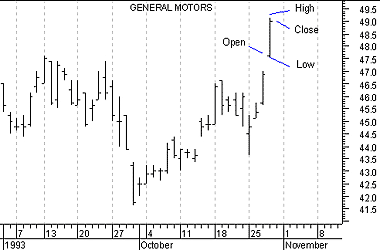
Technical Analysis from A to Z
by Steven B. Achelis
CHARTS
Charts
The foundation of technical analysis is the chart. In this case, a picture truly is worth a thousand words.
Line charts
A line chart is the simplest type of chart. As shown in the chart of General Motors in Figure 2, the single line represents the security's closing price on each day. Dates are displayed along the bottom of the chart and prices are displayed on the side(s).
Figure 2

A line chart's strength comes from its simplicity. It provides an uncluttered, easy to understand view of a security's price. Line charts are typically displayed using a security's closing prices.
Bar charts
A bar chart displays a security's open (if available), high, low, and closing prices. Bar charts are the most popular type of security chart.
As illustrated in the bar chart in Figure 3, the top of each vertical bar represents the highest price that the security traded during the period, and the bottom of the bar represents the lowest price that it traded. A closing "tick" is displayed on the right side of the bar to designate the last price that the security traded. If opening prices are available, they are signified by a tick on the left side of the bar.
Figure 3

Volume bar chart
Volume is usually displayed as a bar graph at the bottom of the chart (see Figure 4). Most analysts only monitor the relative level of volume and as such, a volume scale is often not displayed.
Figure 4

Figure 4 displays "zero-based" volume. This means the bottom of each volume bar represents the value of zero. However, most analysts prefer to see volume that is "relative adjusted" rather than zero-based. This is done by subtracting the lowest volume that occurred during the period displayed from all of the volume bars. Relative adjusted volume bars make it easier to see trends in volume by ignoring the minimum daily volume.
Figure 5

Figure 5 displays the same volume information as in the previous chart, but this volume is relative adjusted.
Other chart types
Security prices can also be displayed using other types of charts, such as candlestick, Equivolume, point & figure, etc. For brevity's sake, explanations of these charting methods appear only in Part II.
Contents
- Preface
- Acknowledgments
- Terminology
- To Learn More
- Bibliography
- About the Author
- Technical Analysis
- Price Fields
- Charts
- Support & Resistance
- Trends
- Moving Averages
- Indicators
- Market Indicators
- Line Studies
- Periodicity
- The Time Element
- Conclusion
- Absolute Breadth Index
- Accumulation/Distribution
- Accumulation Swing Index
- Advance/Decline Line
- Advance/Decline Ratio
- Advancing-Declining Issues
- Advancing, Declining, Unchanged Volume
- Andrews' Pitchfork
- Arms Index
- Average True Range
- Bollinger Bands
- Breadth Thrust
- Bull/Bear Ratio
- Candlesticks - Japanese
- CANSLIM
- Chaikin Oscillator
- Commodity Channel Index
- Commodity Selection Index
- Correlation Analysis
- Cumulative Volume Index
- Cycles
- Demand Index
- Detrended Price Oscillator
- Directional Movement
- Dow Theory
- Ease of Movement
- Efficient Market Theory
- Elliott Wave Theory
- Envelopes (Trading Bands)
- Equivolume/Candlevolume
- Fibonacci Studies
- Four Percent Model
- Fourier Transform
- Fundamental Analysis
- Gann Angles
- Herrick Payoff Index
- Interest Rates
- Kagi
- Large Block Ratio
- Linear Regression Lines
- MACD
- Mass Index
- McClellan Oscillator
- McClellan Summation Index
- Median Price
- Member Short Ratio
- Momentum
- Money Flow Index
- Moving Averages
- Negative Volume Index
- New Highs-Lows Cumulative
- New Highs-New Lows
- New Highs/Lows Ratio
- Odd Lot Balance Index
- Odd Lot Purchases/Sales
- Odd Lot Short Ratio
- On Balance Volume
- Open Interest
- Open-10 TRIN
- Option Analysis
- Overbought/Oversold
- Parabolic SAR
- Patterns
- Percent Retracement
- Performance
- Point & Figure
- Positive Volume Index
- Price and Volume Trend
- Price Oscillator
- Price Rate-of-Change
- Public Short Ratio
- Puts/Calls Ratio
- Quadrant Lines
- Relative Strength, Comparative
- Relative Strength Index
- Renko
- Speed Resistance Lines
- Spreads
- Standard Deviation
- STIX
- Stochastic Oscillator
- Swing Index
- Three Line Break
- Time Series Forcast
- Tirone Levels
- Total Short Ratio
- Trade Volume Index
- Trendlines
- TRIX
- Typical Price
- Ultimate Oscillator
- Upside/Downside Ratio
- Upside/Downside Volume
- Vertical Horizonal Filter
- Volatility, Chaikin's
- Volume
- Volume Oscillator
- Volume Rate-of-Change
- Weighted Close
- Williams' Accumulation/Distribution
- Williams' %R
- Zig Zag